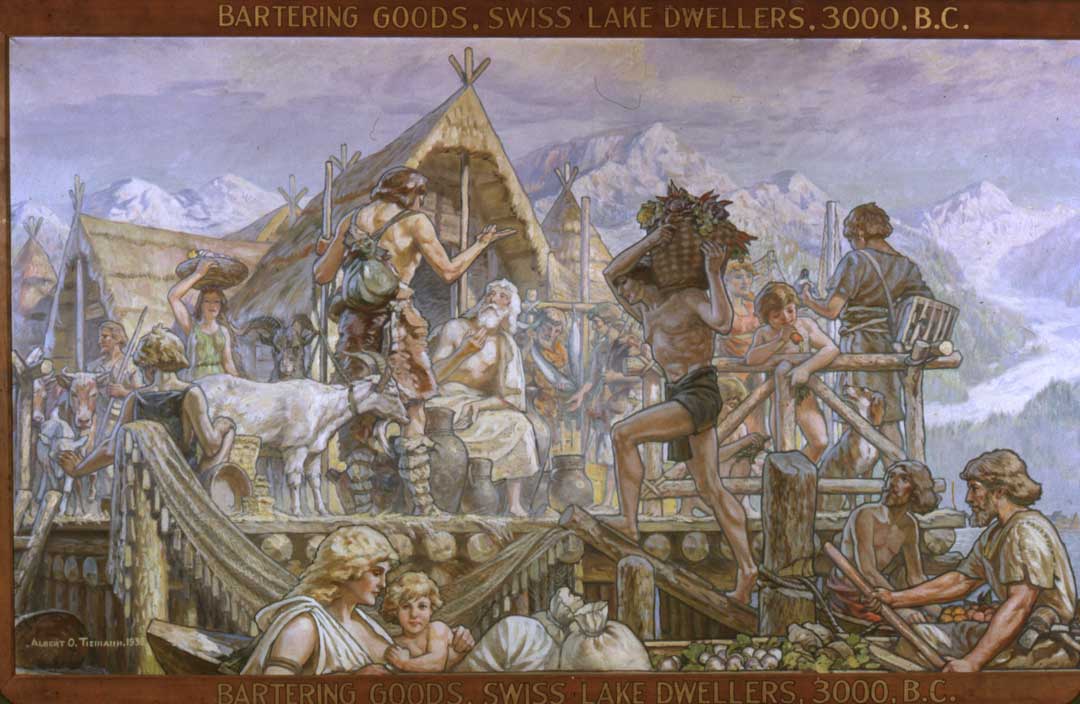Prehistoric Pfahlbau (“pile dwellings”) settlements dotted the Swiss lakeshores between 3,000 and 6,400 years ago, during what is now known as the European Neolithic.
One of the best-known examples of a Pfahlbau settlement is Robenhausen, located just east of Zurich, Switzerland. The inhabitants were largely sedentary agriculturalists who built their wattle-and-daub homes both near and on the lake, which provided for many of the settlements’ needs. They obtained food by herding, hunting, fishing in the lakes, planting and gathering local grains, apples, and other plant foods. To help meet these needs, the Pfahlbau inhabitants created a variety of tools and implements, including axes, adzes, awls, drop spindles, and wooden boats. Examples of several of these items can be found in the MPM collections.
pile Dwelling Fever
After the Pile Dwellings were abandoned, they remained submerged in the lake beds or buried in bog deposits until the winter of 1853-54, when lowering lake levels in the Alpine region began to reveal the remains of these settlements. With the rediscovery of these settlements, a phenomenon known today as “Pfahlbaufieber” (“pile dwelling fever”) began. The relatively sudden rediscovery of these sites prompted some locals to “fish” artifacts out of the lake mud from boats or along the exposed shoreline. While many of these “Pfahlbaufischer” (“pile dwelling fishers”) were looking for items to sell, other amateur archaeologists and scholars, including Jakob Messikommer and Ferdinand Keller, began excavating these sites more systematically. The unusual nature of these items resulted in their distribution to museums worldwide.
Robenhausen and other Swiss lake dwelling sites are particularly notable for the preservation of organic material, ranging from foodstuffs to textiles and wooden tools. These are usually the first items to decompose in an archaeological context and are often absent in modern excavation sites. Since much of the material excavated was submerged in lake beds and bogs for thousands of years, artifacts recovered from these sites allow additional examination of Neolithic life. While early excavators often dismissed their importance, Messikommer’s knowledge of farming helped him recognize the significance of organic materials such as seeds, bark, and other perishable materials; collections from the site around the world tend to be especially rich in botanical remains and textiles. Robenhausen material is found in early museum collections throughout the U.S. and around the world, including the Smithsonian Museum, the Field Museum, the Peabody Museums at both Yale and Harvard, and other museums worldwide that were in existence by the mid-nineteenth century.
MPM Collection
MPM’s collection of Pfahlbau artifacts includes both organic and stone objects. Examples of stone tools include ground stone axes, adzes, and spindle whorls. Organic materials in the MPM collection include bone and antler tools, textiles, wooden objects, and local flora and fauna. Many of these items were collected in the Pfahlbaufieber craze of the late 1800s and early 1900s, and were donated to the museum by early museum supporters, including Charles Doerflinger, William Frankfurth, Max Rosenthal, F.L. Perkins, Adolph Meinecke, Dr. F.A. Renngly (Renngli), and others.
Webpage developed by Erika Ruhl, Anthropology Intern, 2011

Questions? Contact Dawn Scher Thomae or Dr. Bettina Arnold.

